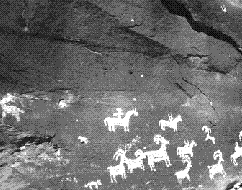Half of the damage is already considered extensive or permanent, with nonrenewable resources -- such as Native cultural sites and historic buildings -- suffering mostly irreparable harm.
Most park managers interviewed by the GAO said that conditions had worsened in the last ten years. National Park Service officials told the investigators that the agency needs more than $4 billion to perform needed maintenance and properly develop the national park system.
Texas park managers worry about frequent repair and production problems at about 170 active oil and gas sites inside park

Threats to National Park Resources
The GAO study identified 127 different "internal" threats, defined as impacts that could directly harm park resources. Most threats fell into one of five categories:
The largest single cause is commercial activity inside the park, along with private property inside or adjacent to the park. According to the GAO, managers at Olympic National Park in Washington State said that homes inside the park threatened groundwater systems and the lake water quality. At Lake Meredith National Recreation Area in Texas, the managers were concerned about the impact of the frequent repair and production problems at about 170 active oil and gas sites and the development of additional sites.
At Arches National Park in Utah, managers told the GAO about an invasive plant called tamarisk, which can consume about 200 gallons of water a day and choke out native vegetation. At Olympic National Park, nonnative mountain goats introduced decades ago have caused significant damage, eliminating or threatening the survival of many rare plant species, including some found nowhere else.
Poaching and hunting are well-known problems, but at both Crater Lake and Olympic national parks, managers complained to the GAO about illegal mushroom harvesting. The commercial sale of mushrooms has increased significantly, a park manger told the GAO, and 'he expressed concern that this multimillion-dollar, largely unregulated industry could damage forest ecosystems through extensive raking or other disruption of the natural ground cover to harvest mushrooms.' Concerns were also expressed about the illegal harvesting of other plant species.
Tourism adds wear and tear, but damage to native plants from the illegal use of off-road vehicles and hikers leaving trails was worst in the west, where desert soil is highly fragile. Vandalism and looting of Native cultural resources was cited, as was damage to historic American structures.
The "unintended adverse effects of the agency's or park managers' actions" mentioned by the GAO included bad management decisions, policies calling for the suppression of naturally caused fires that do not threaten human life or property, and changes in funding or funding priorities.
Six percent of the causes did not fit in any of these categories.
Few park managers have data on the extent and severity of the threats inside their own parks

Rock Art Used for Target Practice, Arches National Park
Managers told investigators that some action has been taken to mitigate most resource threats, but the GAO noted that these measures have generally been limited to closing trails to reduce erosion, installing more rugged equipment to reduce vandalism, and posting signs.
As reported in the Albion Monitor last year, the GAO had previously criticized the Forest Service and Bureau of Land Management for similar neglect of public resources. Like the Park Service, those agencies said maintenance and and repair tasks were given a low priority because of limited funding and agency staffing.
In their current review of the Park Service, the GAO was only able to examine eight national parks because the Park Service does not have a national inventory of the threats to the parks' resources. "Without systemwide data on the threats to the parks' resources," the GAO wrote, "the agency is not fully equipped to meet its mission of preserving and protecting these resources."
Few park managers have data on the extent and severity of the threats inside their own parks, and the GAO concedes that many of its observations are based on ancedotal information from park officials.
According to the GAO, a 1980 Park Service survey found not only that the parks' resources were being harmed, but also that improvements were needed in determining what cultural and natural resources existed in each park, what their condition was, and how and to what extent they were being threatened. Three times since 1987, the GAO reported that the Park Service had made limited progress in meeting the information and monitoring needs identified in 1980. GAO findings included incomplete, out-of-date, or missing resource management plans and an incomplete inventory of threats, their sources, or mitigating actions.
In a 1994 report, the GAO recommended that the Park Service revise its resource management planning system to identify threats, plan actions to mitigate them; and monitor resulting effors. Such an inventory was never implemented, according to Park Service headquarters officials, because of funding and hiring freezes. In commenting on a draft of the current GAO report, the Park Service said that implementing those recommendations are no longer appropriate.

